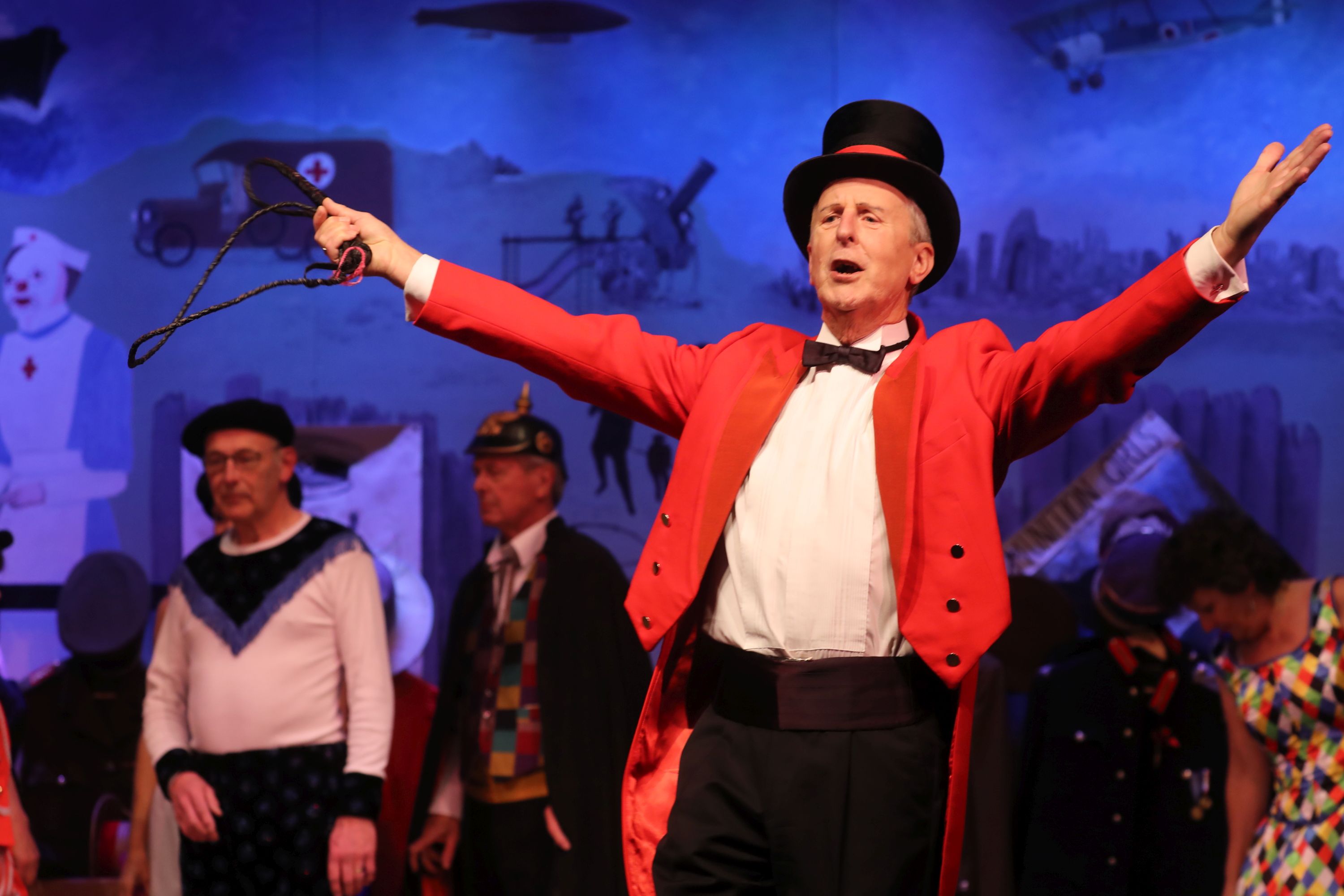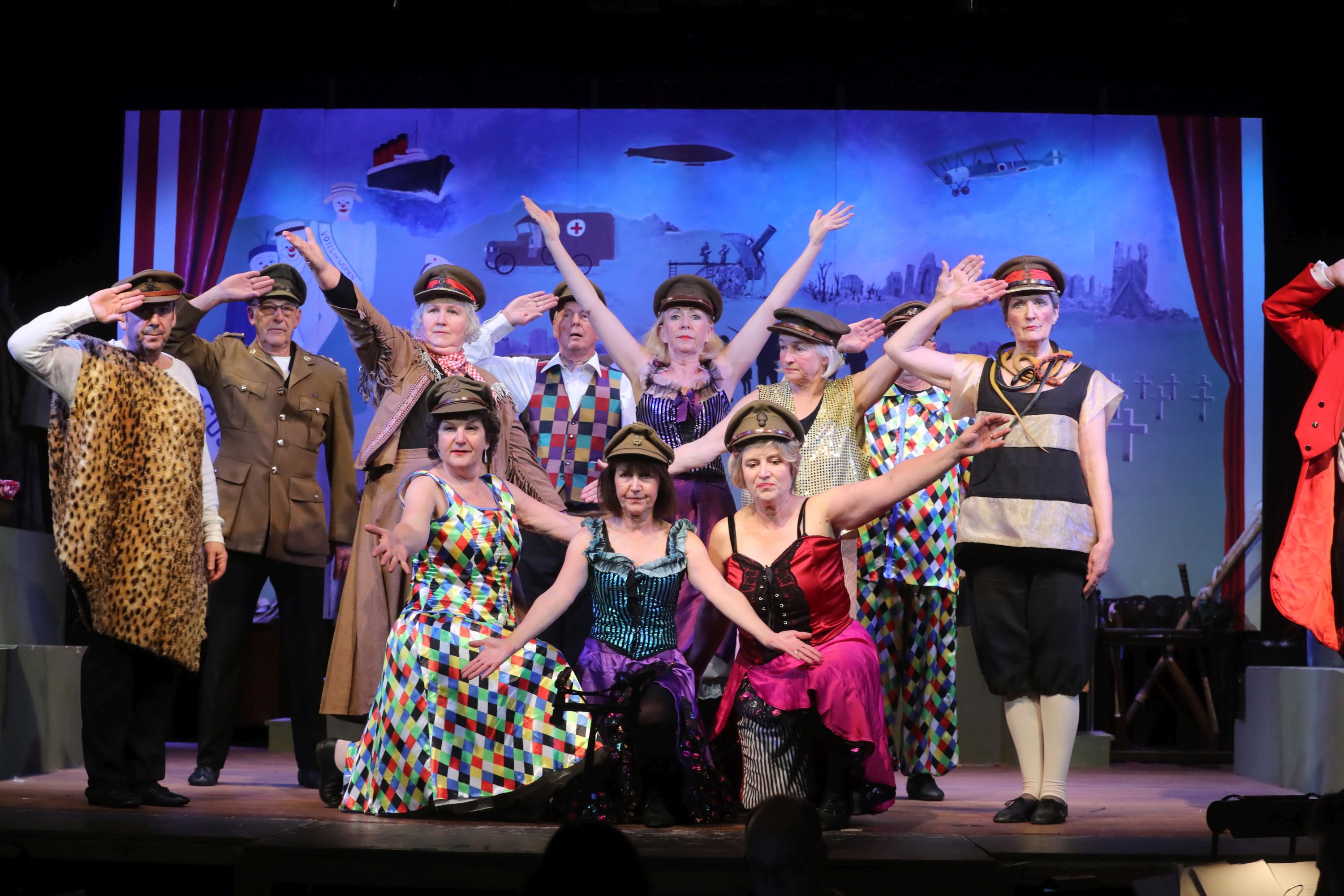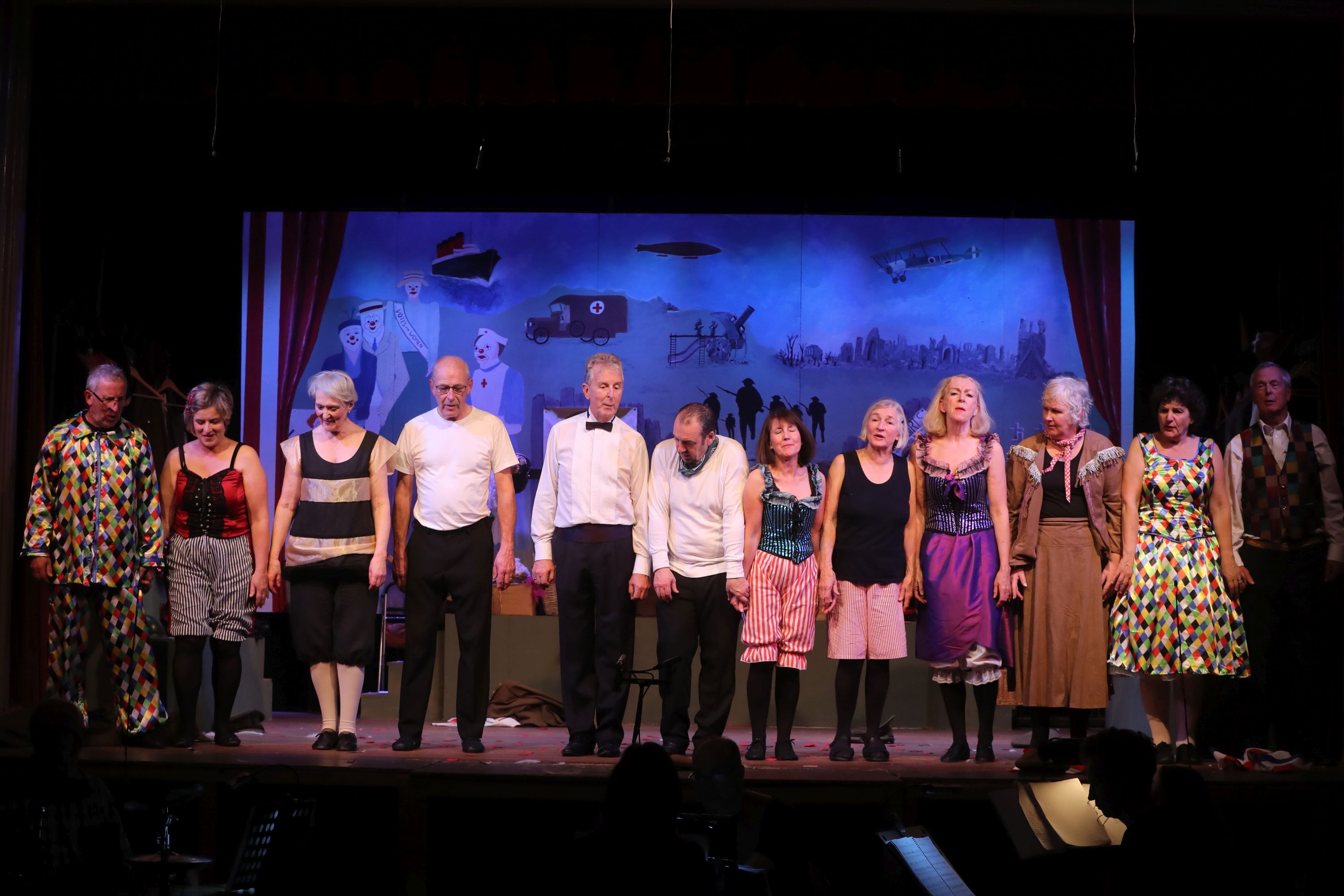Oh What a Lovely War
Information
- Date
- 16th November 2018
- Society
- Grayshott Stagers
- Venue
- Grayshott Village Hall
- Type of Production
- Musical
- Director
- Heather Legat
- Musical Director
- Lizzie Hales
Premiered in 1963 at the Theatre Royal, Stratford under the direction of Joan Littlewood, this show was an instant hit and has become a lasting favourite. Grayshott Stagers decided quite rightly that it would make a very fitting show this November, as we remember the men who fought the 1914-18 war. The show takes us through the war from start to finish using biting satire, and old wartime songs, to show the cruelty and futility of war.
We were given an excellent A4 size programme with a striking cover; a note from the Chair of the Stagers and one from the Director. The excellent cast profiles gave insight into things like family connections to the Great War, and which pieces of the show they found especially moving, or shocking, and were so interesting to read. There were details on many of the songs, and a super double page spread on various historical figures of the day. This greatly enhanced enjoyment and appreciation of the evening.
The Grayshott Stagers provided surely one of the best centenary commemoration events there could possibly have been, for their community and for the local area as a whole. This production was REAL community theatre because not only did they involve the children from Grayshott primary school in the production, but they also put together a wonderful exhibition to accompany it, with the aid of Grayshott Heritage; photographers from the local photography club; and embroiderers from the very talented local embroidery group, and the schoolchildren too. We had therefore not only the production itself to move and delight us in equal measure, we had pottery poppies; superb poetry; moving paintings; photos; exhibits about the Grayshott of 1914-18; and a superb poppy quilt, eyewateringly beautiful. All this, accompanied by two musicians playing and singing songs from the time, which for many of us present were the songs our grandparents, aunts, uncles and parents used to sing or whistle about the house. Marvellous! A real privilege to see and experience. Why do I include details of this exhibition in my report on the show? Because it was an integral part of the evening, which really enhanced our expectations for what was to follow.
So, to the production itself. This ensemble piece gave 12 talented performers the chance to entertain us, inform us, make us think, make us tap our feet, sing along with them, laugh out loud, feel angry, sad, proud, happy too, and even shed a tear. So we the audience had considerable work to do, as well as the cast – surely theatre at its very best.
Just before the action began, we had time to peruse the amazing backdrop, so full of detail we needed that time to take it in, and enjoy it, for itself. We were able to note the props: boxes, trunks; coat hooks; umbrella stands; lacrosse sticks; brollies; walking sticks; a crutch; tunics; hats; shawls; sparkly tops – we were intrigued.
And so the circus began, ringmaster resplendent in red coat and top hat, the troupe of Pierrots milling about. As the action progressed, it became clear that the cast would be on stage throughout, to the front when they were performing, seated at the back when they were not ‘on parade’, so to speak. The hats, tunics, shawls and various sticks were much in evidence, then had to be placed carefully back in the right position, I guess, for when they were needed again. What a complicated operation – what careful planning must have been needed – and the fact that everything worked like clockwork (that’s the way it appeared to the audience, at least!), shows the huge amount of effort, hours, and professionalism involved. And how exhausting for the cast, no chance to have a quick glance at the script to refresh their memories, totally full on, yet how exhilarating it must have been, as it all came together! Wonderful direction of course from Heather Legat.
The action takes us right through the 4 years of that terrible conflict, from the sense of bonhomie; of duty; service to their country; white feathers; Christmas Truce; self-justifying generals’ reckless policies; poison gas; field hospitals; homesickness; keeping the home fires burning; cynicism; return of the wounded at the cessation of hostilities; and the silence that fell as the survivors preferred never to talk about those experiences.
All this, presented to us at such a furious pace, yet nothing passed us by unnoticed, we were able to savour many, many ‘ah yes’ moments. Many more too as we glanced over to the projected statistics and photos on the screen at the side of the stage. Director Heather Legat is quoted in the programme as saying: ‘I love it when a plan comes together!’ And this plan certainly did.
Highlights for me were many. Mary Coyte’s sergeant-major, bullying the raw recruits into shape with her training regime, barking away at them at SUCH a speed! Superb! The rivalry between the generals and their snobby wives. The poignancy of that Christmas Truce played for us by children, the sound of their newly learnt German as they sang ‘Stille Nacht’ – an emotional moment – and exchanged chocolate bars and handshakes. The innocence and cheeriness in Goodbye-ee, WE know what was to come, THEY thought it would all be over in a few months.
One felt relief at the interval, this assault on our senses needed to be internalised over a glass of wine!
The second half began. A masterstroke was Musical Director Lizzie Hales popping up from the orchestra pit curtain to give the most haunting rendition of ‘Roses are Blooming in Picardy’. Another very moving moment. There were loud, rousing, sometimes jolly or ironic moments. There were quiet, thoughtful moments too, such as: ‘There’s a Long Long Trail’, played by Paul Bailey on the harmonica, or ‘Keep the Home Fires Burning’, sung by Mary Coyte, or ‘When this Lousy War is Over’, sung by Steve Musco as he quietly played his guitar.
There was great character acting, especially in the cynical ‘Grouse-Shooting Party’ scene. This showed us the close relationships across the warring nations – Austrian, German, French and English discussing their in-war business arrangements and potential profits, with bizarre results: ‘You mean the German chappies were caught on their OWN barbed wire?’ And in the dance in the Officers’ Mess, where the Best Prop Ever was employed – a tall, elaborate flower display plonked unceremoniously on the head of Richard White to enable lots of surreptitious plotting and whispering to go on in front of it.
We also had a bit of panto-like audience participation, as we were provided with the words of ‘Sister Susie’s Sewing Shirts’. All brilliant fun!
The final moments, though, brought us back down to earth with a bump. ‘And When They Ask Us’, sung quietly by the Ensemble made us remember how those brave men would rarely recount their experiences to relatives after the war – ‘they’ll never believe us’ – the horror of it was, after all, unbelievable. Then the quiet resignation, and cynicism, and humour in ‘Oh It’s a Lovely War’ to end it, with the falling of poppy petals from above.
Thank you, Grayshott Stagers.



© NODA CIO. All rights reserved.

 Show Reports
Oh What a Lovely War
Show Reports
Oh What a Lovely War